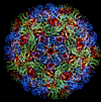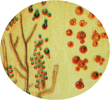| Functional Anatomy of Microbes |  |
| Readings | Presentations | Multiple Choice Quizzes | Key Terms | Questions | Updated 13/02/01 |
![]()
The
further one pursues knowledge the less one knows
Lao-Tse
Who Am I? I discovered haptens and showed the specificity of antibodies for antigens. I am most famous for the discovery of blood groups
| Readings: Functional Anatomy of Microbes | |||
 |
Baron
Medical Microbiology Chap 2 Structure |
 |
Brock
9th Ed Biology of Microorganisms chapters 3, 13, 14, 17 |
| Tortora:
Microbiology An Introduction Chap 4: Functional Anatomy of Microbes |
 |
Jacquelyn
Black 4th Ed Microbiology: Principles & Explorations Chap 4 Characteristics of prokaryotic and eukaryotic cells |
|
| Presentations | Slides | Web Animation | Download |
| Structure | |||
| Cell envelope | |||
| Archaea | |||
| Flagella | |||
| Symbiosis | |||
| DEFINE THE FOLLOWING KEY TERMS | ||||
| Prokaryote | Binary Fission | Coccu | Bacillus | Spiral |
| Diplococci | Streptococci | Staphylococci | Streptobacilli | Coccobacilli |
| Vibrio | Spirilla | Spirochaetes | Lyme Disease | monomorphic |
| pleomorphic | capsule | Slime layer | monotrichious | amphitrichous |
| lophotrichous | peritrichous | chemotaxis | chemoattractant | chemorepellant |
| fimbriae | pilin | Teichoic acids | NAG | NAM |
| Peptidoglycan | Murein | Periplasmic space | Outer Membrane | LPS |
| Lipopolysaccharide | Lipid A | Porins | Pseudomurein | Osmotic lysis |
| plasma membrane | phospholipid bilayer | intergral proteins | mesosomes | endospore |
| isotonic | hypertonic | hypotoic | cytoplasm | nucleoid |
| plasmid | Ribosome | inclusions | magnetosomes | sporulation |
| Germination | glycocalyx | mitochondria | chloroplast | lysosomes |
| endosymbiosis | serial symbiosis | |||